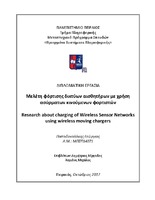Μελέτη φόρτισης δικτύων αισθητήρων με χρήση ασύρματων κινούμενων φορτιστών
Research about charging of Wireless Sensor Networks using wireless moving chargers

Προβολή/
Λέξεις κλειδιά
Ασύρματα δίκτυα αισθητήρων ; Αλγόριθμοι ενεργειακής φόρτισης ; Τεχνολογικές καινοτομίες ; Κινούμενοι φορτιστές ; Ασύρματη φόρτισηΠερίληψη
Ένα ασύρματο δίκτυο αισθητήρων (ΑΔΑ / Wireless Sensor Network - WSN ) αποτελείται από διασκορπισμένους αυτόνομους αισθητήρες για την παρακολούθηση φυσικών ή περιβαλλοντολογικών συνθηκών, όπως η θερμοκρασία, ο ήχος, η ατμοσφαιρική πίεση κτλ. και μέσω συνεργασίας να μεταφέρει τα δεδομένα μέσω του δικτύου σε μια συγκεκριμένη τοποθεσία.
Κατά το σχεδιασμό ενός ασύρματου δικτύου αισθητήρων, υπάρχουν πολλοί σημαντικοί παράγοντες, οι οποίοι θα πρέπει να ληφθούν υπ’ όψιν. Μερικοί από αυτούς, είναι το περιβάλλον στο οποίο θα τοποθετηθεί το δίκτυο, οι περιορισμοί στο υλικό, η ανοχή σε σφάλματα και το κόστος παραγωγής. Έναν από τους σημαντικότερους παράγοντες, αποτελεί η διαχείριση των ενεργειακών πόρων των κόμβων των αισθητήρων, οι οποίοι απαρτίζουν αυτά τα δίκτυα.
Η τεχνολογία ασύρματης φόρτισης, είναι μία πολλά υποσχόμενη τεχνολογία. Οι σύγχρονες εξελίξεις στον τομέα αυτό, καθώς και οι εξελίξεις σχετικά με τα υλικά των μπαταριών που μπορούν να χρησιμοποιηθούν, ανοίγουν το δρόμο για νέες ευκαιρίες, οι οποίες αφορούν τον τρόπο διαχείρισης της ενέργειας στα δίκτυα αισθητήρων.
Η παρούσα πτυχιακή έχει ως αντικείμενο τον σχεδιασμό και την υλοποίηση ενός Αλγορίθμου Ενεργειακής Φόρτισης Σε Δίκτυο Αισθητήρων, ο οποίος θα λαμβάνει υπόψιν του όλα τα παραπάνω. Στο πρώτο μέρος, γίνεται μια παρουσίαση των δικτύων αισθητήρων καθώς επίσης περιγράφονται τα μέρη που το απαρτίζουν, οι παράγοντες που το επηρεάζουν και οι εφαρμογές για τις οποίες μπορεί να χρησιμοποιηθεί. Στη συνέχεια, γίνεται μια ανάλυση του προβλήματος της κατανάλωσης ενέργειας, το οποίο παρατηρείται σε τέτοιου είδους δίκτυα και παρουσιάζονται διάφορες προσεγγίσεις που έχουν προηγηθεί. Παράλληλα, γίνεται αναφορά σε θέματα δρομολόγησης και σε πρωτόκολλα που αφορούν τα δίκτυα αισθητήρων, καθώς αποτελούν βασικό συστατικό τους.
Στο τελευταίο μέρος της παρούσας διπλωματικής, γίνεται μια προσπάθεια υλοποίησης αλγορίθμου για την φόρτιση των κόμβων δικτύου αισθητήρων. Στην προσπάθεια αυτή, λαμβάνονται υπ’ όψιν και συνδυάζονται δυο αλγόριθμοι φόρτισης από παλιότερες εργασίες. Ο ένας έχει να κάνει με τη φόρτιση των κόμβων από κινούμενους φορτιστές, ενώ ο δεύτερος με τη φόρτιση των φορτιστών από άλλους μεγαλύτερους. Η υλοποίηση γίνεται σε περιβάλλον Matlab και αφού παρουσιαστούν τα αποτελέσματα μέσω γραφικών παραστάσεων, παρατίθενται συμπεράσματα και προτάσεις πάνω στις οποίες θα μπορούσε να βασιστεί και να συνεχιστεί η μελέτη.


